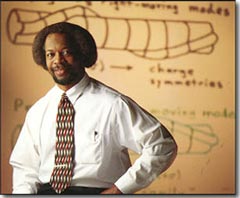Jim Gates
Sitting in Mr. Coney's physics class, as a junior in a segregated high school, Jim Gates had an epiphany. Mr. Coney had just shown the class that when a ball rolls down an inclined plane, the distance the ball travels is proportional to the square of time it has rolled. When Gates learned that a simple equation could describe the motion of the rolling ball, he knew he wanted to be a physicist.
“I recognized physics as something I wanted to do, because it combines very different parts of our experience,” Gates said. “On one hand, because it relies on mathematics, physics can be thought of as an element of our imaginations. On the other hand, physics has a strange property of taking this part of our imagination and saying, 'this is the reality that exists outside our heads.' And the universe did not have to be that way.” Gates continues to apply his love of mathematics as the John S. Toll Professor of Physics at the University of Maryland. Now, he says, “Mathematics, for the theoretical physicist, is an extra sensory perception organ.”

Jim Gates
Photo: UMD
Gates's father was in the military, so his family moved frequently when he was young. His mother died when he was eleven. After his father re-married, the family settled in Orlando, Florida, where Gates went to a segregated high school. He almost didn't go to college, but his father and stepmother convinced him to apply to MIT in 1969. He was accepted, graduated as a double mathematics/physics major in 1973, and stayed there to get his Ph.D. (1977). In 1975, he was searching for a thesis project when saw a mathematical symbol he had never seen before. “I said, 'wow, that's interesting.” The symbol had only first been used a year earlier. It came from a field called supersymmetry, an attempt to reconcile different aspects of matter and energy.
General relativity describes how stars and galaxies work, and quantum mechanics describes how individual atoms, and smaller subatomic particles, behave. The two theories work perfectly well in their own domains, but they make no sense when they are put together. Supersymmetry and its close relative, superstring theory, tries to show how general relativity and quantum mechanics can both be explained within one theory.
Supersymmetry may help to resolve the contradiction by looking at the universe's fundamental particles. The universe is made of two apparently different things * matter and energy (such as light). The two have different properties, Gates explains. You can't put your hand through a wall, but two flashlight beams can pass through one another easily. Supersymmetry suggests that matter and light may not be so different after all. “It says that things like electrons and things like photons, or particles of light, have a lot more in common than we thought.” Gates said. “So it's sort of a unifying view.” Gates's 1977 thesis was the first one written on aspects of supersymmetry at MIT. He still works on developing supersymmetric theories today.
Gates is the father of twins born in 1993. He enjoys bowling and horesback riding. “When I was younger I used to love to dance,” he said, “in the year 2000, I became 50 years old, and my knees can't take it anymore." He also enjoys reading history. Like many physicists, Gates admires Albert Einstein. “Einstein was a minority in his society too,” Gates said. “Where he was, and when he was, the majority of physicists were not Jewish. He wrote about facing discrimination. Not just for his achievements as a scientist, but for his deep understanding of humanity, he is a very great hero of mine.”











